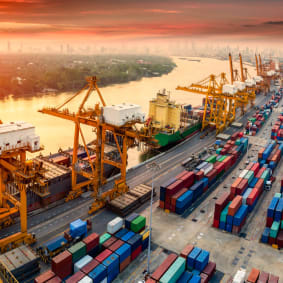October 1, 2025 6 mins
Geopolitical Volatility: Preparing for the Unpredictable

Geopolitical volatility ranks ninth globally in 2025 — and is forecast to rise to fifth by 2028. With conflict, trade disruption and political instability on the rise, organizations must monitor global developments, regularly assess operational exposure and conduct scenario planning.
Key Takeaways
-
Recent geopolitical conflicts have disrupted trade and made it unpredictable.
-
The rising cost of living, shifts in economic policies and social upheaval have resulted in voter dissatisfaction, changing governments and protests.
-
Organizations can withstand geopolitical volatility by monitoring global developments, assessing impact on business functions, exploring risk transfer and fostering organizational agility.
Geopolitical Volatility is a Rising Threat for Businesses
Geopolitical volatility risk has surged since the start of 2024, so it comes as no surprise that this risk has been ranked in the top 10 for the first time since we started the Global Risk Management Survey in 2007. Global uncertainty and turmoil amid an historic wave of elections, new and ongoing regional conflicts, and shifting trade and economic landscapes have magnified other risks, such as cyber, making conducting business even more complex and unpredictable. 1
Quote icon
The past year has demonstrated that executives need to adopt a decision-making framework for risk that can match the velocity of geopolitical events. This dynamic approach needs to be informed by analytics and contemplate the role of risk capital in offsetting the impact from these events.
What’s Driving Geopolitical Volatility?
Elections
More than 60 countries held significant votes in 2024, with many incumbent governments losing due to voter dissatisfaction over rising prices, reduced living conditions and the pace of social change. Populist sentiments were widespread, and voters worldwide expressed a sense that their governments are not reflecting their interests or their values. The “year of elections” catalyzed an increase in misinformation campaigns (using deepfake and AI technology) from politically backed groups to influence election results or sow distrust, leading to heightened tensions.
Regional Conflicts
The Russia-Ukraine War and conflict in the Middle East are creating ripple effects across markets and disrupting trade and supply chains. For example, since the start of the Israel-Palestine conflict, regular Houthi attacks on shipping in the Red Sea have led to higher shipping costs and insurance premiums. The re-escalation of other territorial disputes, such as the brief conflict between India and Pakistan, underscores the heightened volatility in global affairs. There is also growing apprehension about the proliferation of newer, more affordable and easily accessible weapon systems being deployed in various regional conflict zones.
Trade Tensions
In 2025, new tariffs (and retaliatory measures prompted by those new tariffs) have increased costs for businesses, squeezed margins and disrupted supply chains, forcing companies to rapidly rethink their sourcing and manufacturing strategies — along with any planned business expansions, mergers and investments.
Economic Pressures and Social Upheaval
Governments and businesses worldwide faced persistent inflation, tightening monetary policies and rapid shifts in economic, tax and trade policies in 2024 and 2025. In many regions, economic hardships heightened political volatility, sometimes spurring protests and social upheaval. Such upheaval also increases threats from piracy, theft and political violence.

Top 10 Global Risks
Building Resilience: How to Manage Risks from Geopolitical Volatility
Continuously Monitor Global and Regional Developments
Staying ahead of geopolitical risks begins with robust monitoring. With advanced analytics and intelligence platforms, businesses can identify and prepare for instability such as election outcomes, shifts in policy and regulations, economic sanctions or escalating conflicts.
Assess Impacts on Operations, Supply Chains and Markets
Assessing how geopolitical shifts might affect an organization’s operations, supply chains and markets is key to managing geopolitical risk. This involves mapping key dependencies, identifying vulnerabilities and conducting scenario planning.
Explore Risk Transfer
Working with experienced brokers and advisors, organizations can tailor risk transfer solutions to address their specific exposures and risk tolerances. Political risk insurance, for example, can protect against losses stemming from expropriation, political violence or government actions that disrupt business operations. Trade credit insurance and supply chain risk coverage offer additional protection against non-payment or disruptions caused by geopolitical instability.
Foster Organizational Agility and Resilience
Beyond monitoring and risk transfer, companies must ensure they have built agility and resilience into their organizations. This includes developing crisis response plans, diversifying supply chains and investing in business continuity strategies.
Why It Matters
Volatility is the new normal. To navigate this landscape effectively, organizations must adopt a proactive and comprehensive approach to risk management by leveraging available insights and tools. They must also be prepared to act with agility and respond quickly to new developments.
+12
Geopolitical volatility has risen twelve places since our previous survey, entering the global top ten for the first time.
1 “Top Geopolitical Risks of 2025,” S&P Global, 2025.
2 Richard Wike, Moira Fagan and Laura Clancy, “Global Elections in 2024: What We Learned in a Year of Political Disruption,” Pew Research Center, December 11, 2024.
3 “Israel Raw Materials Supply Chain Affected by Israel-Hamas Conflict,” International Trade Administration, September 26, 2024, Lance Roberts, “The Iran-Israel Conflict And The Likely Impact On The Market,” Real Investment Advice, June 16, 2025.
4 Richard Partington, “Global markets in turmoil as Trump tariffs wipe $2.5tn off Wall Street,” The Guardian, April 4, 2025, Sophia Miller, “The Impact of Geopolitical Tensions on International Trade,” Global Trade Magazine, May 16, 2025.
5 Spencer Feingold, “Why trade tensions are a ‘storm cloud’ over financial markets,” World Economic Forum, April 17, 2025.
6Policy Pivot, Rising Threats, International Monetary Fund, October 2024.
7 Patricia Justino, “Revisiting the links between economic inequality and political violence: The role of social mobilization,” World Development 185, no. 106820 (January 2025).
General Disclaimer
This document is not intended to address any specific situation or to provide legal, regulatory, financial, or other advice. While care has been taken in the production of this document, Aon does not warrant, represent or guarantee the accuracy, adequacy, completeness or fitness for any purpose of the document or any part of it and can accept no liability for any loss incurred in any way by any person who may rely on it. Any recipient shall be responsible for the use to which it puts this document. This document has been compiled using information available to us up to its date of publication and is subject to any qualifications made in the document.
Terms of Use
The contents herein may not be reproduced, reused, reprinted or redistributed without the expressed written consent of Aon, unless otherwise authorized by Aon. To use information contained herein, please write to our team.






